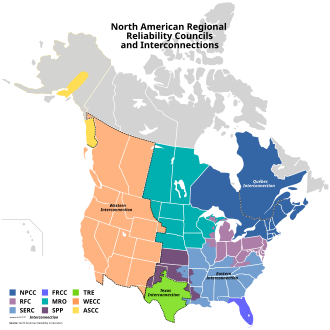Texas Interconnection

The Texas Interconnection is an alternating current (AC) power grid – a wide area synchronous grid – that covers most of the state of Texas. The grid is managed by the Electric Reliability Council of Texas (ERCOT).
The Texas Interconnection is one of the three minor grids in the continental U.S. power transmission grid. The other two minor interconnections are the Quebec Interconnection and the Alaska Interconnection. The two major interconnections are the Eastern Interconnection and the Western Interconnection. The Texas Interconnection is maintained as a separate grid for political, rather than technical reasons.[1]
All of the electric utilities in the Texas Interconnection are electrically tied together during normal system conditions and operate at a synchronized frequency operating at an average of 60 Hz.
Interconnections can be tied to each other via high-voltage direct current power transmission lines (DC ties), or with variable-frequency transformers (VFTs), which permit a controlled flow of energy while also functionally isolating the independent AC frequencies of each side. The Texas Interconnection is tied to the Eastern Interconnection with two DC ties, and has a DC tie and a VFT to non-NERC systems in Mexico. There is one AC tie switch in Dayton, Texas that has been used only one time in its history (after Hurricane Ike).
On October 13, 2009, the Tres Amigas SuperStation was announced to connect the Eastern, Western and Texas Interconnections via three 5 GW superconductor links.[2] As of 2017[update], the project was reduced in scope and only related infrastructure was constructed for nearby wind projects connecting to the Western Interconnection.
Power demand is highest in summer, primarily due to air conditioning use in homes and businesses. The region's all-time record peak hour occurred on July 19, 2018, when consumer demand hit 73,259 MW.[3] A megawatt of electricity can power about 200 Texas homes during periods of peak demand.
Electric Reliability Council of Texas
The Electric Reliability Council of Texas (ERCOT) manages the flow of electric power on the Texas Interconnection that supplies power to 24 million Texas customers – representing 85 percent of the state's electric load.[4] ERCOT is the first independent system operator (ISO) in the United States[5] and one of nine ISOs in North America.[6] ERCOT works with the Texas Reliability Entity (TRE),[7] one of eight regional entities within the North American Electric Reliability Corporation (NERC) that coordinate to improve reliability of the bulk power grid.[8]
As the ISO for the region, ERCOT dispatches power on an electric grid that connects 46,500 miles of transmission lines and more than 550 generation units.[9] ERCOT also performs financial settlements for the competitive wholesale bulk-power market and administers retail switching for 7 million premises in competitive choice areas.[10]
ERCOT is a membership-based 501(c)(4) nonprofit corporation, governed by a board of directors and subject to oversight by the Public Utility Commission of Texas (PUC) and the Texas Legislature.[11][12]
ERCOT's members include consumers, electric cooperatives, generators, power marketers, retail electric providers, investor-owned electric utilities (transmission and distribution providers), and municipally owned electric utilities.[13]
Power demands in the ERCOT region are highest in summer, primarily due to air conditioning use in homes and businesses. The ERCOT region's all-time record peak hour occurred on July 19, 2018, when consumer demand hit 73,259 MW.[14] A megawatt of electricity can power about 200 Texas homes during periods of peak demand.
References
- ^ http://www.slate.com/articles/news_and_politics/explainer/2003/08/why_texas_has_its_own_power_grid.html
- ^ High-Temp Superconductors To Connect Power Grids
- ^ "Texas is using a record amount of electricity. Could demand outpace supply?".
- ^ [1]
- ^ ERCOT History, http://www.ercot.com/about/profile/history/
- ^ ISO/RTO Council homepage, "Archived copy". Archived from the original on 2012-12-27. Retrieved 2013-04-22.
{{cite web}}: Unknown parameter|deadurl=ignored (|url-status=suggested) (help)CS1 maint: archived copy as title (link) - ^ Texas Reliability Entity homepage,"Archived copy". Archived from the original on 2013-03-28. Retrieved 2013-04-22.
{{cite web}}: Unknown parameter|deadurl=ignored (|url-status=suggested) (help)CS1 maint: archived copy as title (link) - ^ NERC, http://www.nerc.com/page.php?cid=1%7C9%7C119
- ^ ERCOT Quick Facts, October 2017, http://www.ercot.com/content/wcm/lists/114739/ERCOT_Quick_Facts_101317.pdf
- ^ ERCOT Quick Facts, http://www.ercot.com/content/wcm/lists/114739/ERCOT_Quick_Facts_101317.pdf
- ^ ERCOT Governance, http://www.ercot.com/about/governance/
- ^ About ERCOT, http://www.ercot.com/about/
- ^ ERCOT membership, http://www.ercot.com/about/governance/members/
- ^ Wind helped ERCOT with July heat wave, but probably won't in August: staff, https://www.spglobal.com/platts/en/market-insights/latest-news/electric-power/080718-wind-helped-ercot-with-july-heat-wave-but-probably-wont-in-august-staff/
